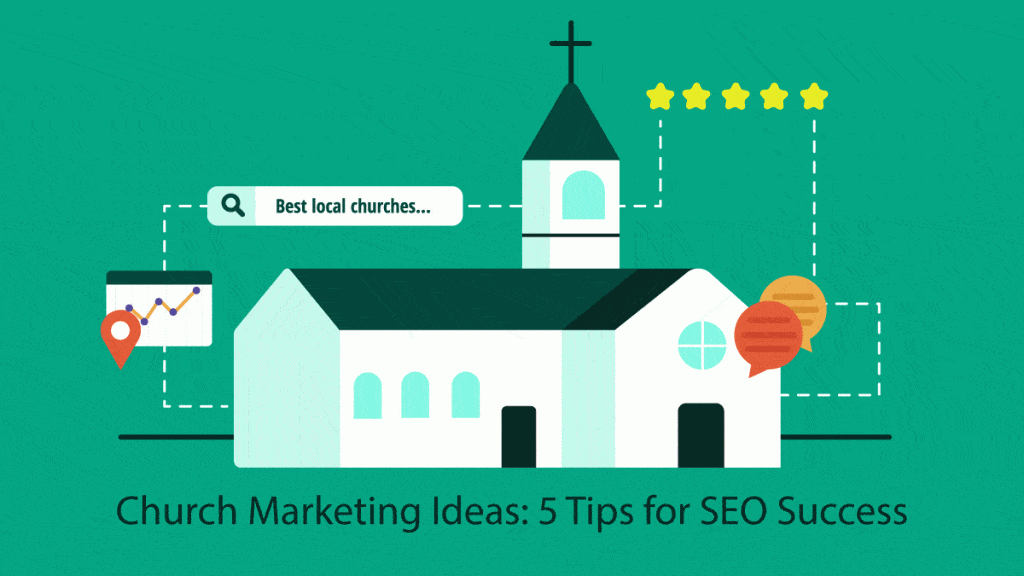Church Marketing Ideas: 5 Tips for SEO Success
Although search engine optimization (SEO) doesn’t sound like a key objective for churches, it’s an important aspect of any church’s marketing to ensure your services are found online. And perhaps the most daunting task of all is trying to decide where your efforts should start. After all, marketing can encompass a wide breadth of skills and trades.
Here’s a hint: Start where the vast majority of people look when they don’t know an answer — Google.
With a few simple steps and SEO best practices in mind, you can increase traffic, viewership, and active parishioners.
Claim Your Listing
First thing’s first, claim your Google listing. Your church should stand out, especially if you’re in a crowded metropolitan area. In order to accomplish that, you need to be at the top of the search results. This is known as “local SEO.”

This top spot is determined by a few different local ranking factors, but in order to climb to this position, you must first appropriately verify and update your listing.
Like any local business, churches need to be found with ease, and the best way ensure this is through Google My Business. This simple process allows you to verify the location, phone number, and website of your church, which is imperative for visitors to find you. Claiming this local listing gives you the opportunity to respond to reviews, answer questions and even add relevant photos.

Create Content
Now that church-seekers are able to find your location and website, the next step is optimizing content to create the best church website. This is the time to focus on ranking factors that will keep your ministry at the top of the search engine results after visitors scroll past the local listings.

One of the most important ranking factors on any website is quality content. You may have heard of Google’s Panda Update, which targeted websites with low-quality content and removed them from the search results.
However, what you may not realize is that your content (possibly with rich SEO keywords and relevant subject matter) is already living on your site — in videos! That being said, Google bots (the crawlers that scan your site for ranking factors) can’t see or watch videos.
Use Transcription
Many churches use Rev’s transcription services to make video content easily searchable. If a video is transcribed, Google bots can read the transcriptions and know exactly what content is contained within the video.
This service is particularly important for church marketing because a sermon transcription can easily become a long-form piece of content. And generally speaking, marketers need content to be around 800-2000 words. This is the estimated length it takes to provide enough explanation of a topic and show Google you’re an expert. As an added bonus, it was recently found in an Ahrefs study that if you’re ranking well for one keyword, you could potentially be ranking for thousands of other keywords. It’s all connected. A top Google ranking will increase traffic to your site, which allows more opportunities to reach current or potential church members.
Think Details
Having content is a great start, but there are a few more steps to ensure it actually ranks. To do this, you need to think from the top down, starting with the title tag. This tag is a large ranking factor for Google. It’s also what shows up in the search results, so it needs to entice visitors to click.
![]()

Title tags should be kept between 50-60 characters, include your keyword/topic at the front of the tag, and provide the church name at the end (for consistency). Just confirm that your keyword is relevant to the topic you’re discussing in the content. Your main priority should always be to optimize the site so it’s relevant to users, not search engines.
You should also optimize the URL of every page. Fortunately, this is a fairly simple task with many of today’s CMS platforms. When deciding on a URL, keep it as short as possible and include a variation of your target keyword. It’s as easy as that.
![]()
Just remember you want each URL on your site to be shareable, so the less number of characters you use the better.
Be Descriptive
When striving toward best practices for church SEO, also consider alt text and closed captioning. Alt text is used to describe an image and closed captioning is used to describe a video. Both are important.
The primary use of alt text is to describe an image for those who are visually impaired. Google views it as a ranking factor because crawlers are unable to see images. Just like videos, Google bots use the alt text to determine what the images look like on a page. When optimizing alt texts, be as descriptive as possible.
Captions provide a similar service for videos. This is especially important since the vast majority of videos are now watched without sound. From a user experience, it’s important to be able to provide viewers the opportunity to read. Just like transcripts, Google can crawl captions, meaning the content within your video becomes a ranking signal.
Wrap-up
Start by ensuring your church is relevant in the community with up-to-date local listing information. Then take the time to create relevant content, which can easily be done with transcription services or closed captioning. From there, optimize your title tags, URLs and alt text around the content you’re creating. Soon you’ll start climbing your way to the top of the search results.




